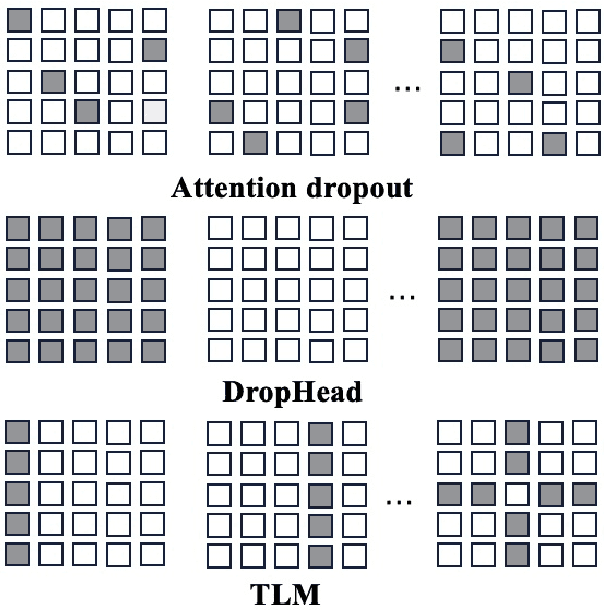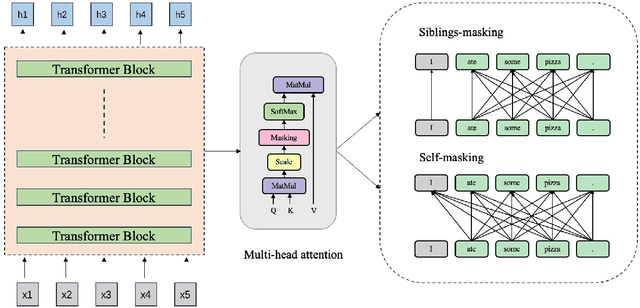Kebin Fang
TLM: Token-Level Masking for Transformers
Oct 28, 2023



Abstract:Structured dropout approaches, such as attention dropout and DropHead, have been investigated to regularize the multi-head attention mechanism in Transformers. In this paper, we propose a new regularization scheme based on token-level rather than structure-level to reduce overfitting. Specifically, we devise a novel Token-Level Masking (TLM) training strategy for Transformers to regularize the connections of self-attention, which consists of two masking techniques that are effective and easy to implement. The underlying idea is to manipulate the connections between tokens in the multi-head attention via masking, where the networks are forced to exploit partial neighbors' information to produce a meaningful representation. The generality and effectiveness of TLM are thoroughly evaluated via extensive experiments on 4 diversified NLP tasks across 18 datasets, including natural language understanding benchmark GLUE, ChineseGLUE, Chinese Grammatical Error Correction, and data-to-text generation. The results indicate that TLM can consistently outperform attention dropout and DropHead, e.g., it increases by 0.5 points relative to DropHead with BERT-large on GLUE. Moreover, TLM can establish a new record on the data-to-text benchmark Rotowire (18.93 BLEU). Our code will be publicly available at https://github.com/Young1993/tlm.
FF2: A Feature Fusion Two-Stream Framework for Punctuation Restoration
Nov 09, 2022



Abstract:To accomplish punctuation restoration, most existing methods focus on introducing extra information (e.g., part-of-speech) or addressing the class imbalance problem. Recently, large-scale transformer-based pre-trained language models (PLMS) have been utilized widely and obtained remarkable success. However, the PLMS are trained on the large dataset with marks, which may not fit well with the small dataset without marks, causing the convergence to be not ideal. In this study, we propose a Feature Fusion two-stream framework (FF2) to bridge the gap. Specifically, one stream leverages a pre-trained language model to capture the semantic feature, while another auxiliary module captures the feature at hand. We also modify the computation of multi-head attention to encourage communication among heads. Then, two features with different perspectives are aggregated to fuse information and enhance context awareness. Without additional data, the experimental results on the popular benchmark IWSLT demonstrate that FF2 achieves new SOTA performance, which verifies that our approach is effective.
A Context-Aware Feature Fusion Framework for Punctuation Restoration
Mar 23, 2022



Abstract:To accomplish the punctuation restoration task, most existing approaches focused on leveraging extra information (e.g., part-of-speech tags) or addressing the class imbalance problem. Recent works have widely applied the transformer-based language models and significantly improved their effectiveness. To the best of our knowledge, an inherent issue has remained neglected: the attention of individual heads in the transformer will be diluted or powerless while feeding the long non-punctuation utterances. Since those previous contexts, not the followings, are comparatively more valuable to the current position, it's hard to achieve a good balance by independent attention. In this paper, we propose a novel Feature Fusion framework based on two-type Attentions (FFA) to alleviate the shortage. It introduces a two-stream architecture. One module involves interaction between attention heads to encourage the communication, and another masked attention module captures the dependent feature representation. Then, it aggregates two feature embeddings to fuse information and enhances context-awareness. The experiments on the popular benchmark dataset IWSLT demonstrate that our approach is effective. Without additional data, it obtains comparable performance to the current state-of-the-art models.
 Add to Chrome
Add to Chrome Add to Firefox
Add to Firefox Add to Edge
Add to Edge